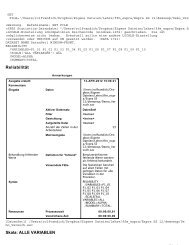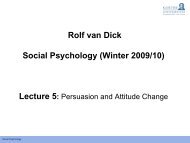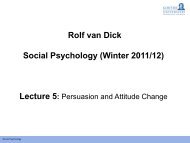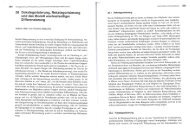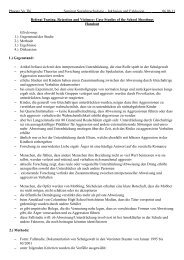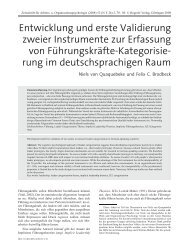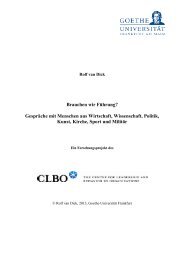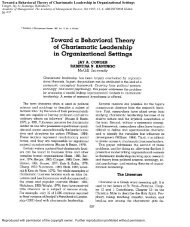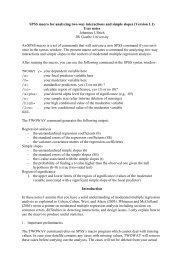Social Identity Theory and Self-categorization Theory: A Historical ...
Social Identity Theory and Self-categorization Theory: A Historical ...
Social Identity Theory and Self-categorization Theory: A Historical ...
Create successful ePaper yourself
Turn your PDF publications into a flip-book with our unique Google optimized e-Paper software.
206 <strong>Social</strong> <strong>Identity</strong> <strong>Theory</strong> <strong>and</strong> <strong>Self</strong>-<strong>categorization</strong> <strong>Theory</strong><br />
Sometimes, the points carried value (in terms of being able to be traded<br />
for money), but participants were explicitly told that they personally could<br />
not benefit from their own point allocation strategy. In other experiments,<br />
the points did not carry value at all (Turner, 1978).<br />
Faced with this curious dilemma, one might expect the points allocation<br />
to be either r<strong>and</strong>om, or to be made on the basis of a strategy of fairness<br />
(equal numbers of points to members of each group). But this was not<br />
what was found. Instead, participants tended to give more points to members<br />
of their own group than to members of the outgroup. In fact, there was<br />
some evidence that participants were prepared to give relatively few points<br />
to either group if it allowed them to maximize the extent to which they<br />
favored their ingroup. Although stripped of history <strong>and</strong> context, the<br />
experiments were not psychologically empty because participants were<br />
obeying a predictable pattern of responding, <strong>and</strong> one that was difficult to<br />
explain according to traditional theories of intergroup relations. Tajfel et<br />
al. (1971) initially argued that the participants were obeying a norm of<br />
competitive group behaviour. But where did this norm come from? Why<br />
competition, <strong>and</strong> not fairness or some other strategy? The answers to<br />
these questions were later formalized in social identity theory (SIT; Tajfel,<br />
1978; Tajfel & Turner, 1979). 3<br />
In articulating the theory, Henri Tajfel (in collaboration with his graduate<br />
student John Turner) argued that human interaction ranges on a spectrum<br />
from being purely interpersonal on the one h<strong>and</strong> to purely intergroup on<br />
the other. A purely interpersonal interaction (which Tajfel <strong>and</strong> Turner<br />
believed to be rare) involves people relating entirely as individuals, with<br />
no awareness of social categories. A purely intergroup interaction is one<br />
in which people relate entirely as representatives of their groups, <strong>and</strong><br />
where one’s idiosyncratic, individualizing qualities are overwhelmed by<br />
the salience of one’s group memberships. It was argued that sliding from<br />
the interpersonal to the intergroup end of the spectrum results in shifts in<br />
how people see themselves <strong>and</strong> each other.<br />
Drawing on his own social cognition work (Tajfel & Wilkes, 1963), Tajfel<br />
argued that the mere process of making salient ‘us <strong>and</strong> them’ distinctions<br />
changes the way people see each other. When category distinctions are<br />
salient, people perceptually enhance similarities within the group (‘we’re all<br />
much the same’) <strong>and</strong> enhance differences among the group (‘we’re different<br />
from them’). Categorization also changes the way people see themselves,<br />
in the sense that it activates a different level of one’s self-concept. At the<br />
interpersonal end of the spectrum, people’s self-concept will mostly comprise<br />
the attitudes, memories, behaviours, <strong>and</strong> emotions that define them as<br />
idiosyncratic individuals, distinct from other individuals (one’s ‘personal<br />
identity’). At the intergroup end of the spectrum, self-concept will mostly<br />
comprise one’s ‘social identity’, defined as those aspects of an individual’s<br />
self-image that derive from the social categories to which he/she belongs, as<br />
well as the emotional <strong>and</strong> evaluative consequences of this group membership.<br />
© 2008 The Author <strong>Social</strong> <strong>and</strong> Personality Psychology Compass 2/1 (2008): 204–222, 10.1111/j.1751-9004.2007.00066.x<br />
Journal Compilation © 2008 Blackwell Publishing Ltd




